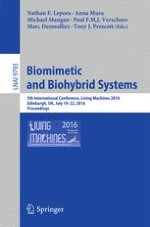2016 | OriginalPaper | Buchkapitel
A Neural Network with Central Pattern Generators Entrained by Sensory Feedback Controls Walking of a Bipedal Model
verfasst von : Wei Li, Nicholas S. Szczecinski, Alexander J. Hunt, Roger D. Quinn
Erschienen in: Biomimetic and Biohybrid Systems
Aktivieren Sie unsere intelligente Suche, um passende Fachinhalte oder Patente zu finden.
Wählen Sie Textabschnitte aus um mit Künstlicher Intelligenz passenden Patente zu finden. powered by
Markieren Sie Textabschnitte, um KI-gestützt weitere passende Inhalte zu finden. powered by
